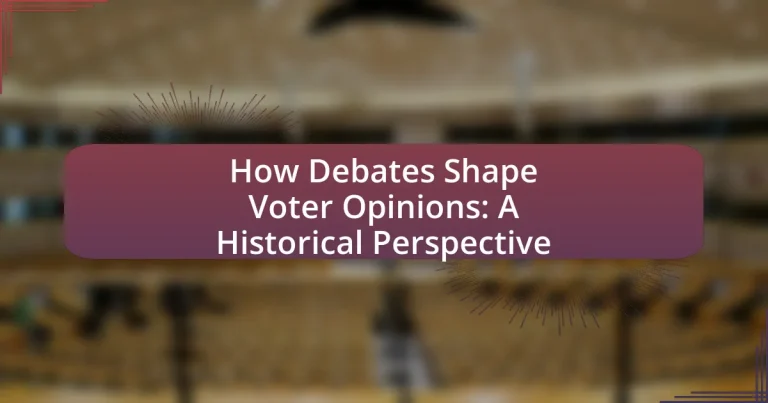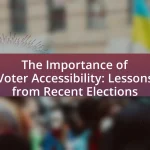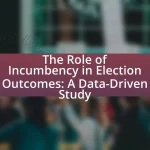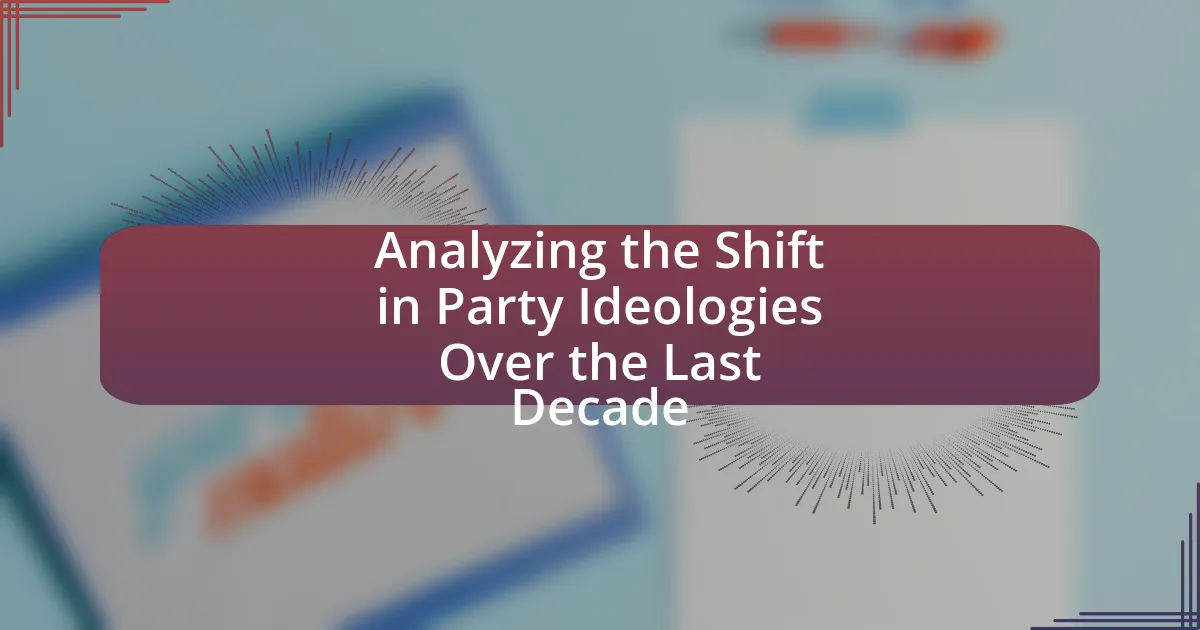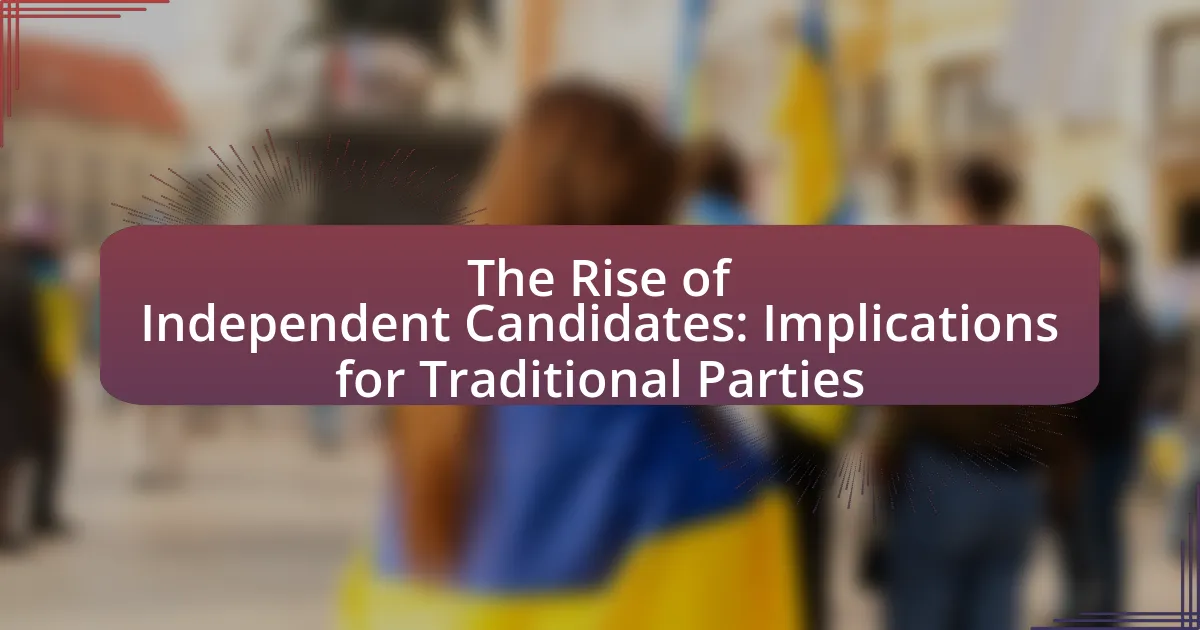The article examines the historical influence of debates on voter opinions, highlighting key moments such as the 1960 Kennedy-Nixon debate and the Lincoln-Douglas debates of 1858. It discusses how debates serve as platforms for candidates to present their policies and engage with opponents, shaping public perception and voter sentiment. The article also explores the impact of media coverage, psychological effects on voters, and strategies candidates use to sway opinions during debates. Additionally, it provides insights into how voters can critically evaluate debate performances and make informed electoral choices based on candidates’ communication styles and policy positions.

How have debates historically influenced voter opinions?
Debates have historically influenced voter opinions by providing a platform for candidates to articulate their policies and engage directly with their opponents, thereby shaping public perception. For instance, the 1960 Kennedy-Nixon debate marked a significant shift in how televised debates could sway voters; Kennedy’s confident demeanor contrasted sharply with Nixon’s appearance, leading to a notable increase in support for Kennedy among viewers. Additionally, studies indicate that debates can reinforce existing opinions or sway undecided voters, as seen in the 1984 Reagan-Mondale debate, where Reagan’s performance helped solidify his lead in the polls. Historical data shows that debates often serve as pivotal moments in elections, impacting voter decisions and altering the trajectory of campaigns.
What role did early political debates play in shaping public perception?
Early political debates significantly influenced public perception by providing a platform for candidates to articulate their policies and engage directly with opposing viewpoints. These debates allowed voters to assess candidates’ character, communication skills, and positions on key issues, thereby shaping their opinions and electoral choices. For instance, the Lincoln-Douglas debates of 1858 showcased contrasting views on slavery, which not only highlighted the candidates’ ideologies but also galvanized public discourse on the issue, ultimately impacting the political landscape leading up to the Civil War. Such historical examples demonstrate that early political debates were crucial in informing and swaying public opinion, as they facilitated direct engagement and critical evaluation of political ideas.
How did the Lincoln-Douglas debates impact voter sentiment in the 1860s?
The Lincoln-Douglas debates significantly influenced voter sentiment in the 1860s by elevating the national discourse on slavery and highlighting the stark ideological differences between the candidates. These seven debates, held in 1858 during the Illinois Senate race, showcased Abraham Lincoln’s opposition to the expansion of slavery and Stephen A. Douglas’s advocacy for popular sovereignty. The debates attracted large audiences and extensive media coverage, which helped to inform and mobilize voters. As a result, Lincoln’s articulate arguments against slavery’s expansion resonated with many voters, contributing to his eventual election as President in 1860. The debates not only shaped public opinion but also solidified the Republican Party’s stance against slavery, reflecting a growing national divide that would culminate in the Civil War.
What were the key issues discussed in early debates that resonated with voters?
Key issues discussed in early debates that resonated with voters included economic policies, civil rights, and foreign relations. Economic policies, particularly regarding taxation and government spending, were crucial as they directly impacted voters’ financial well-being. Civil rights discussions highlighted the importance of equality and justice, appealing to voters’ moral values and social concerns. Foreign relations, especially during times of conflict or international tension, influenced voters’ perceptions of national security and leadership. These topics were pivotal in shaping voter opinions and determining electoral outcomes, as evidenced by historical elections where candidates’ stances on these issues significantly swayed public support.
How did the advent of radio and television change the dynamics of political debates?
The advent of radio and television significantly transformed the dynamics of political debates by enhancing accessibility and immediacy of information to the public. Radio allowed candidates to reach a broader audience, breaking geographical barriers, while television added a visual element that influenced public perception through non-verbal cues such as body language and appearance. For instance, the 1960 Kennedy-Nixon debate showcased how television favored Kennedy’s charismatic presence over Nixon’s less polished appearance, impacting voter opinions and election outcomes. This shift marked a transition from print-based political discourse to a more dynamic, visual medium, fundamentally altering how candidates communicated and engaged with voters.
What were the effects of the 1960 Kennedy-Nixon debate on voter opinions?
The 1960 Kennedy-Nixon debate significantly influenced voter opinions, marking a pivotal moment in American political history. The televised debate showcased John F. Kennedy’s charisma and poise against Richard Nixon’s less polished appearance, leading to a shift in public perception. Polls conducted immediately after the debate indicated that viewers believed Kennedy performed better, with a CBS poll showing 81% of viewers favoring Kennedy over Nixon. This debate is often credited with helping Kennedy gain momentum in the election, ultimately contributing to his victory by a narrow margin. The impact of the debate highlighted the importance of media presentation in shaping voter opinions, demonstrating that visual appeal could sway public sentiment in a way that traditional campaigning had not.
How did media coverage shape the public’s perception of candidates during debates?
Media coverage significantly shaped the public’s perception of candidates during debates by influencing the narrative and framing of their performances. For instance, televised debates in the 1960 presidential election between John F. Kennedy and Richard Nixon showcased how visual presentation and media commentary affected voter opinions; Kennedy’s confident demeanor contrasted with Nixon’s less polished appearance, leading to a shift in public favor towards Kennedy. Studies, such as those conducted by the Pew Research Center, indicate that media framing can amplify specific traits or gaffes, thereby altering how candidates are perceived by the electorate. This demonstrates that the way media presents debate content can directly impact voter attitudes and decisions.
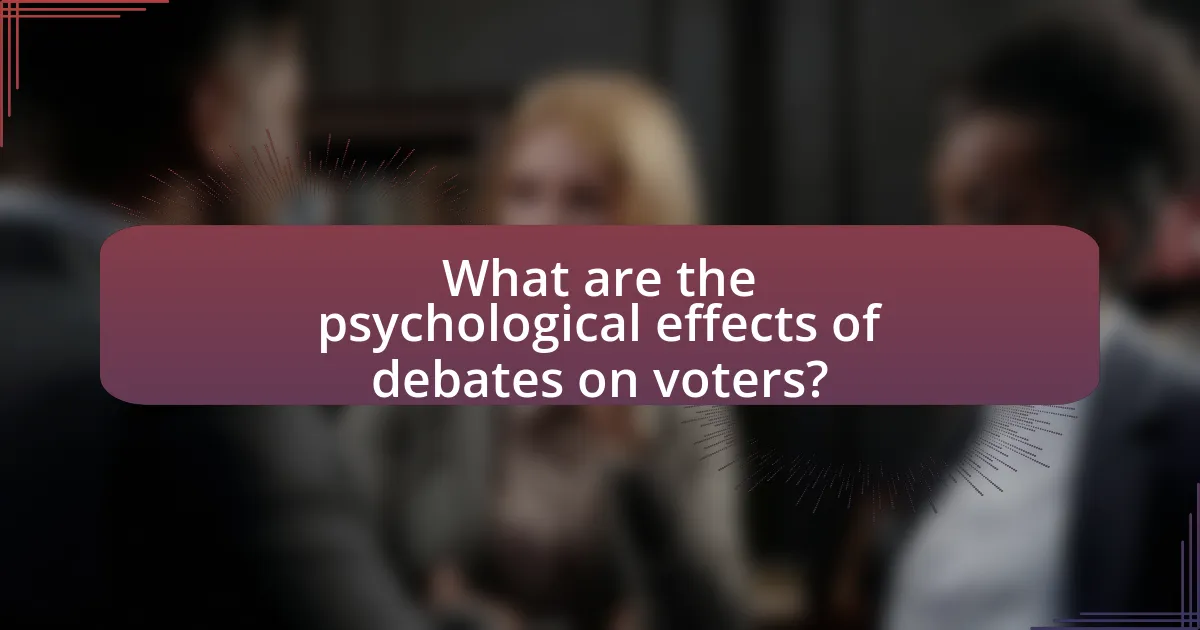
What are the psychological effects of debates on voters?
Debates significantly influence voters’ psychological states by shaping their perceptions, attitudes, and decision-making processes. Research indicates that debates can enhance voter engagement, increase political knowledge, and reinforce existing beliefs, often leading to confirmation bias where voters favor information that aligns with their pre-existing views. For instance, a study by the Pew Research Center found that 62% of debate viewers reported that the debates helped them better understand the candidates’ positions, demonstrating the debates’ role in informing voter opinions. Additionally, debates can evoke emotional responses, such as excitement or anxiety, which can further impact voter motivation and turnout.
How do debates influence voter emotions and decision-making?
Debates significantly influence voter emotions and decision-making by providing a platform for candidates to present their policies and personalities directly to the electorate. This direct engagement allows voters to form emotional connections or disconnections based on candidates’ performances, rhetoric, and demeanor. Research indicates that debates can sway undecided voters; for instance, a study by the Pew Research Center found that 63% of debate watchers reported that the debates influenced their opinions about the candidates. Additionally, emotional responses elicited during debates, such as empathy or anger, can lead to shifts in voter preferences, as demonstrated in the 2008 presidential debates where Barack Obama’s calm demeanor contrasted with John McCain’s more aggressive style, impacting voter perceptions significantly.
What psychological theories explain the impact of debates on voter behavior?
Psychological theories that explain the impact of debates on voter behavior include the Elaboration Likelihood Model (ELM) and Social Identity Theory. The Elaboration Likelihood Model posits that voters process information through either a central route, focusing on the quality of arguments, or a peripheral route, influenced by superficial cues such as the candidates’ appearance or charisma. Research indicates that when debates present strong arguments, voters are more likely to change their opinions based on the content, demonstrating the model’s relevance in understanding voter behavior during debates. Social Identity Theory suggests that voters’ affiliations with political parties or candidates shape their perceptions and reactions during debates, leading to biased interpretations of information that align with their group identity. Studies have shown that individuals often favor candidates who reflect their social identity, impacting their voting decisions. These theories collectively illustrate how debates can significantly influence voter behavior through cognitive processing and social affiliations.
How do candidates’ performances in debates affect voter trust and credibility?
Candidates’ performances in debates significantly influence voter trust and credibility. Effective debate performances can enhance a candidate’s perceived competence and authenticity, leading to increased voter confidence. For instance, a study by the Pew Research Center found that 67% of viewers reported feeling more favorable towards a candidate after a strong debate performance. Conversely, poor performances can diminish trust, as voters may perceive candidates as unprepared or insincere. Historical examples, such as the 1960 Kennedy-Nixon debates, illustrate this impact; Kennedy’s confident demeanor contrasted with Nixon’s less effective presentation, contributing to a shift in public perception and voter support.
What strategies do candidates use to sway voter opinions during debates?
Candidates use several strategies to sway voter opinions during debates, including emotional appeals, fact-based arguments, and direct engagement with opponents. Emotional appeals, such as personal stories or relatable anecdotes, can create a connection with voters, making candidates seem more trustworthy and relatable. Fact-based arguments involve presenting statistics or evidence to support their positions, which can enhance credibility and persuade undecided voters. Additionally, candidates often engage directly with their opponents to highlight contrasts in policies or character, aiming to position themselves as the more favorable choice. Historical examples, such as the 1960 Kennedy-Nixon debates, illustrate how these strategies can significantly influence public perception and voting behavior.
How do rhetorical techniques enhance a candidate’s appeal in debates?
Rhetorical techniques enhance a candidate’s appeal in debates by effectively persuading and engaging the audience. Techniques such as ethos, pathos, and logos allow candidates to establish credibility, evoke emotions, and present logical arguments, respectively. For instance, a candidate who shares personal stories (pathos) can create an emotional connection with voters, making their message more relatable and impactful. Additionally, using rhetorical questions can provoke thought and encourage audience participation, further increasing engagement. Historical examples, such as Barack Obama’s use of storytelling in the 2008 presidential debates, demonstrate how these techniques can resonate with voters and influence public perception.
What role does body language play in influencing voter perceptions during debates?
Body language significantly influences voter perceptions during debates by conveying confidence, sincerity, and engagement. Research indicates that nonverbal cues, such as posture, facial expressions, and gestures, can impact how candidates are perceived by voters. For instance, a study published in the journal “Political Psychology” by McHugo et al. (2018) found that candidates who exhibited open body language were more likely to be viewed favorably compared to those with closed or defensive postures. This suggests that effective body language can enhance a candidate’s appeal and potentially sway voter opinions.

How can understanding the history of debates inform future electoral strategies?
Understanding the history of debates can significantly inform future electoral strategies by revealing patterns in voter behavior and the effectiveness of various rhetorical techniques. Historical debates, such as the Lincoln-Douglas debates of 1858, demonstrate how candidates’ positions and presentation styles can sway public opinion and influence election outcomes. For instance, Lincoln’s ability to articulate moral arguments against slavery resonated with voters, showcasing the impact of framing issues effectively. Analyzing past debates allows strategists to identify successful communication strategies, adapt to contemporary issues, and anticipate voter reactions, thereby enhancing their campaign approaches.
What lessons can modern candidates learn from historical debates?
Modern candidates can learn the importance of preparation and authenticity from historical debates. For instance, John F. Kennedy’s poised performance in the 1960 debate against Richard Nixon showcased how effective presentation can influence public perception, leading to a significant boost in Kennedy’s popularity. Additionally, candidates should recognize the impact of clear messaging, as seen in Ronald Reagan’s 1984 debate, where his ability to connect with voters through relatable language helped solidify his re-election. These examples illustrate that thorough preparation and genuine communication are crucial for resonating with voters and shaping their opinions.
How can candidates effectively prepare for debates based on past successes and failures?
Candidates can effectively prepare for debates by analyzing their past performances and those of their opponents to identify strengths and weaknesses. For instance, reviewing previous debate transcripts allows candidates to pinpoint successful strategies, such as effective rebuttals or persuasive arguments, while also recognizing mistakes, like unclear messaging or failure to address key issues. Historical examples, such as John F. Kennedy’s successful use of television in the 1960 debates, demonstrate the importance of presentation and audience engagement. By learning from these instances, candidates can refine their messaging and delivery, ensuring they resonate with voters and avoid past pitfalls.
What are the best practices for engaging voters through debate performances?
The best practices for engaging voters through debate performances include clear communication, relatable messaging, and active audience engagement. Clear communication ensures that candidates articulate their positions effectively, making complex issues understandable. Relatable messaging connects candidates with voters on personal and emotional levels, fostering trust and resonance. Active audience engagement, such as addressing questions and incorporating real-time feedback, enhances voter involvement and interest. Historical examples, such as the Kennedy-Nixon debates in 1960, demonstrate that candidates who effectively utilized these practices significantly influenced voter perceptions and decisions.
How can voters critically evaluate debate performances?
Voters can critically evaluate debate performances by analyzing candidates’ clarity, coherence, and responsiveness to questions. Clarity involves how well candidates articulate their positions, while coherence assesses the logical flow of their arguments. Responsiveness measures how effectively candidates address the questions posed by moderators or opponents. Research indicates that voters often prioritize these factors, as evidenced by studies showing that clear and coherent arguments significantly influence voter perceptions and decisions. For instance, a study by the Pew Research Center found that 70% of viewers rated clarity as a crucial factor in their evaluation of debate performances.
What criteria should voters consider when assessing candidates during debates?
Voters should consider candidates’ clarity of communication, policy positions, and ability to engage with opponents during debates. Clarity of communication ensures that voters understand candidates’ messages and proposals, which is crucial for informed decision-making. Policy positions reveal candidates’ priorities and values, allowing voters to assess alignment with their own beliefs. Engaging with opponents demonstrates a candidate’s ability to handle criticism and defend their views, which can indicate leadership qualities. Historical data shows that debates significantly influence voter perceptions; for instance, the 1960 Kennedy-Nixon debate highlighted how effective communication can sway public opinion, with Kennedy’s confident demeanor contributing to his electoral success.
How can voters use debate insights to make informed electoral choices?
Voters can use debate insights to make informed electoral choices by analyzing candidates’ positions, communication styles, and responses to questions during debates. This analysis allows voters to assess candidates’ qualifications and alignment with their values. Historical data shows that debates significantly influence voter perceptions; for instance, the 1960 Kennedy-Nixon debate demonstrated how televised performance can sway public opinion, with Kennedy’s confident demeanor appealing to viewers and contributing to his electoral success. By critically evaluating debate performances, voters can better understand candidates’ policies and character, leading to more informed voting decisions.
